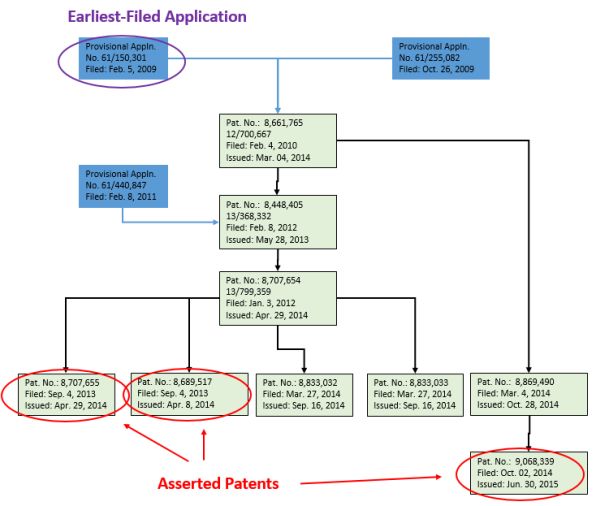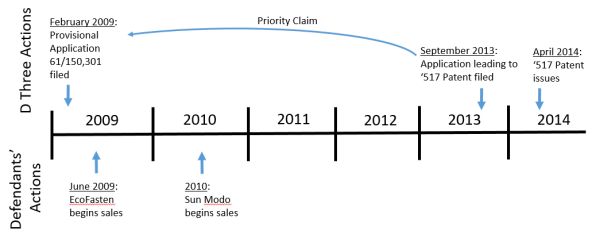- The U.S. Court of Appeals for the Federal Circuit found three patents directed to solar panel mounting technology to have defective priority claims. As a result, the allegedly-infringing products sold by EcoFasten and SunModo pre-date the patents, rendering the patents invalid.
The U.S. Court of Appeals for the Federal Circuit recently affirmed the invalidity of three patents directed to solar panel mounting technology. The patents are owned by solar installer D Three Enterprises LLC, and were asserted in federal court against SunModo Corporation and Rillito River Solar LLC, which does business under the name EcoFasten Solar. Now that the three patents have been affirmed as invalid, D Three's lawsuit against SunModo and EcoFasten will potentially be dismissed.
As shown in Figure 1 below, the three patents at issue are part of a patent family having seven U.S. patents. Patent families are commonly used by patent applicants, in part because they allow for claiming the "priority," or filing date, of an earlier-filed application. Claiming priority can be advantageous when attempting to demonstrate that the claimed invention meets one of the key requirements for patentability: that the claimed invention is new and non-obvious over existing technology as of the priority date.

Figure 1. The D Three Patent Family
For example, the patent application that became D Three's asserted U.S. Patent No. 8,689,517 was filed September 4, 2013. However, by claiming priority back to the earlier and related U.S. Provisional Application No. 61/150,301, D Three is able to assert an effective filing date of February 5, 2009 for the '517 Patent. This means that when evaluating whether the claimed invention of the '517 Patent is new and non-obvious over existing technology, the Patent Office will only look at technology existing prior to February 5, 2009 rather than September 4, 2013. Thus, an effective priority claim can negate years of additional developments in the relevant technological field that could otherwise invalidate a later-filed application.
To be effective, the priority claim must reach back to an earlier application that sufficiently describes the claimed invention. In the D Three case, three patents were asserted that were filed between September 2013 and October 2014, but all three claimed priority back to February 2009. The claimed inventions of the asserted patents were roof mount sealing assemblies that allow a user to mount objects (such as solar panels) to a roof while sealing the mounting location against water.
As shown in the timeline of Figure 2 below, the key question in this case was whether D Three's priority claim back to 2009 was effective. EcoFasten began selling its roof mount product in June 2009, and SunModo followed with its own sales of a similar product in 2010. If D Three's priority claim is effective, then the asserted patents pre-date EcoFasten and SunModo's product sales. However, an ineffective priority claim would render EcoFasten and SunModo's products part of the existing technology, and D Three's asserted patents would be invalid because the claimed inventions would no longer be considered new and non-obvious over the existing technology.

Figure 2. Timeline of Key Events
The trial court in Colorado ruled that the priority claim was not effective because inventions claimed in the asserted patents (filed in 2013 and 2014) were not sufficiently described in the application filed in February 2009. D Three appealed that decision to the Federal Circuit, which agreed with the Colorado court. The Federal Circuit affirmed the finding of the trial court that the priority claim of D Three's asserted patents were ineffective. Without an effective priority claim, the claimed inventions were not new over existing technology (i.e. EcoFasten's product sold in June 2009) and the patents were therefore invalid.
The case will now likely return to the Colorado court for further proceedings consistent with the Federal Circuit's decision.
Disclaimer: This Alert has been prepared and published for informational purposes only and is not offered, nor should be construed, as legal advice. For more information, please see the firm's full disclaimer.
